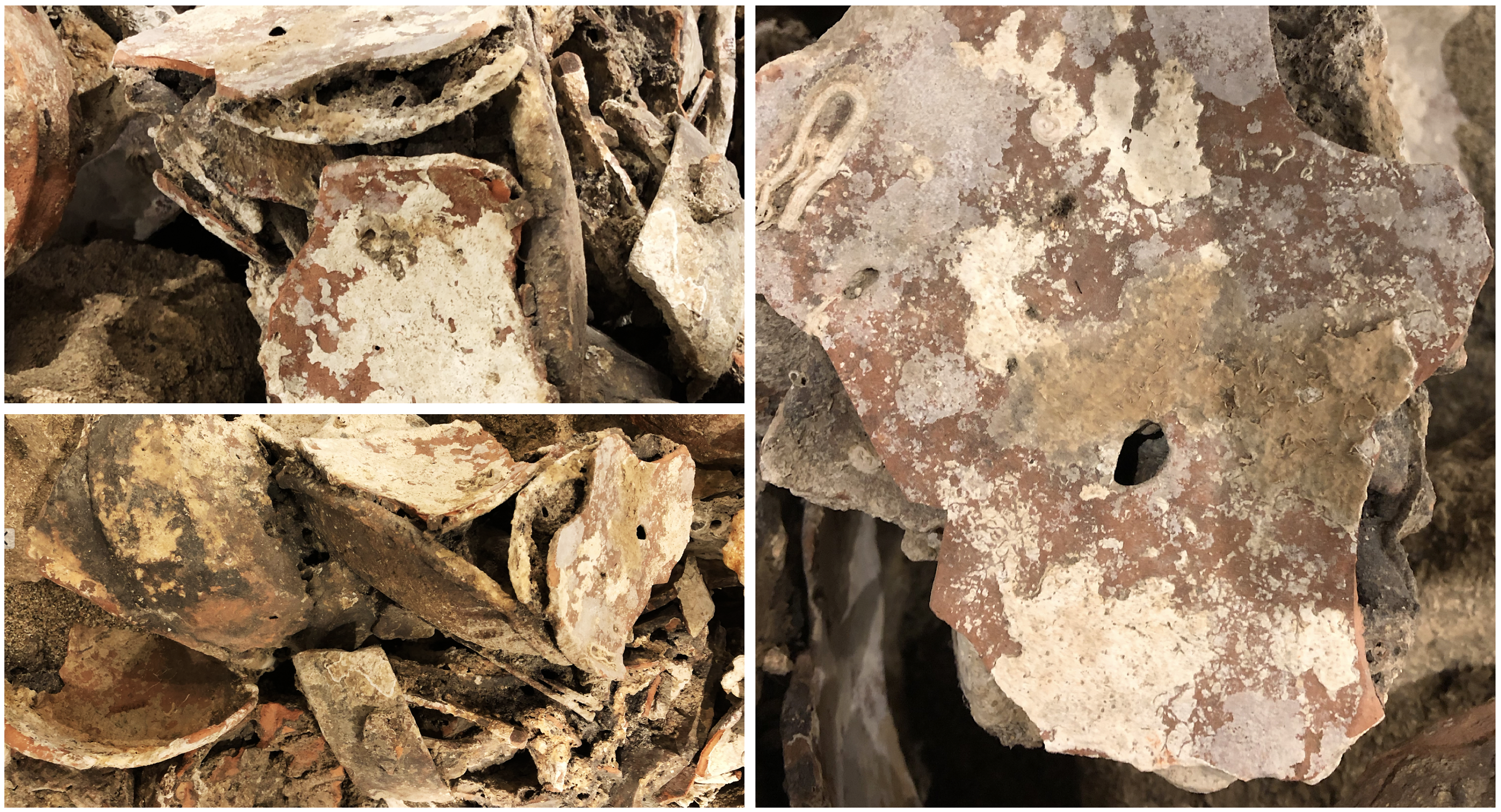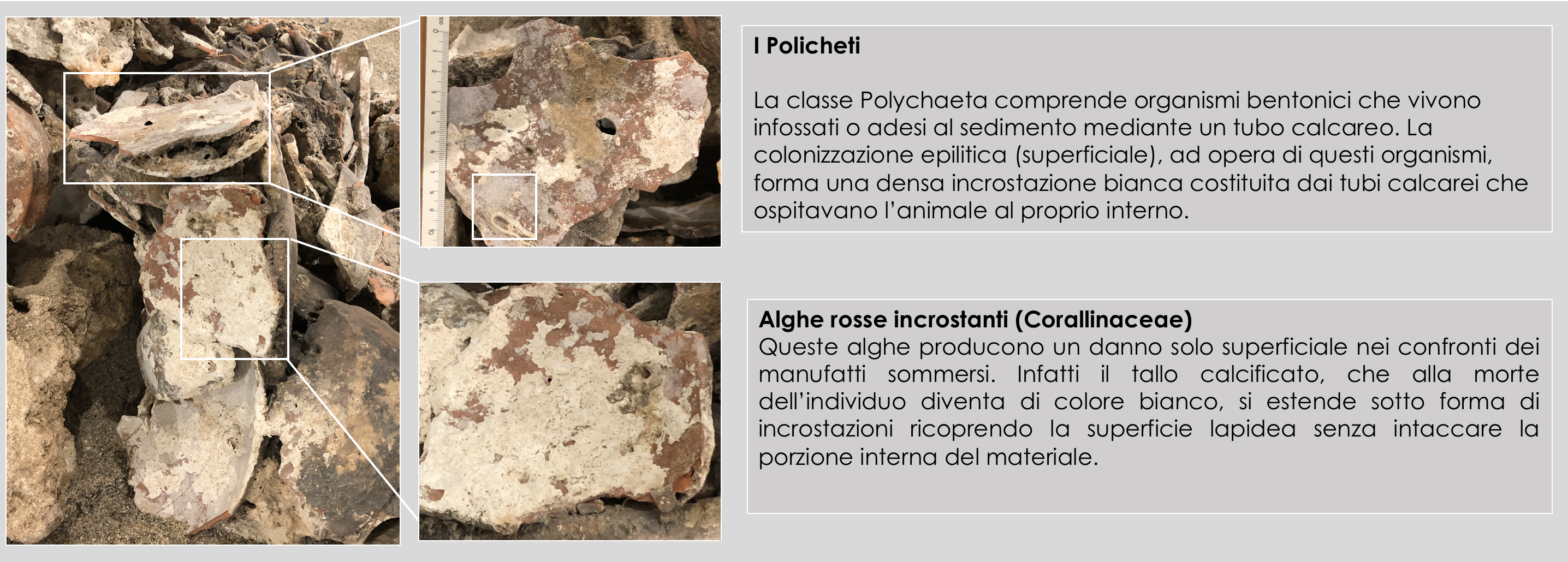WRECK OF SCOGLIO DELLA SIRENA. HALF OF III CENTURY A.D.
AFRICAN KITCHENWARE
MUSAS Ref. No.:
CAPCOL-07
Inv. No.
Description
Pieces of African kitchenware, concreted together. There are both productions with light grey patina with a blackened rim and productions with stripes and bands.
The types found on the wreck are comparable to plates-lids Hayes 196, lids Hayes 195 (Atlante I, CV, nn. 3-4), casseroles Hayes 197 / Ostia III, fig. 267, casseroles Hayes 23B/ Lamboglia 10A, bowls Lamboglia 9A/Hayes 181, lids Fulford 1994, LI4, deep casseroles Hayes 193 and plates-lids Atlante I, tab. CIV, n. 9.
Dimensions
cm 33 x 27 x 32
Materials
Terracotta
Location
Sandpit in the National Archaeological Museum of Capo Colonna
Origin
Wreck of Scoglio della Sirena
Dating
Mid-III century A.D.
Biological degradation

The fragments of pottery show – on both external and internal surfaces – a mixed colonisation with a prevailing presence of sedentary Polychaeta (sea worms), encrusting red algae thalli visible as a whitish and rosy patina, and Bryozoans. There are still visible traces of epilithic, not encrusting algal thalli of a green-brownish and yellow ochre colour.
References
MEDAGLIA, ROSSI 2010
REFERENCES
Medaglia S., Rossi D. 2010, Un carico di ceramiche africane dal relitto dello “,Scoglio della Sirena” (Crotone), in LRCW III. Late Roman Coarse Wares, Cooking Wares and Amphorae in the Mediterranean: archaeology and archaeometry, BAR Int. Series 2185, Oxford, pp. 515-524
AFRICAN KITCHENWARE 2
MUSAS Ref. No.:
CAPCOL-08
Inv. No.
Description
Concreted pieces of African kitchenware. There are both productions with light grey patina with a blackened rim and productions with stripes and bands.
The types found on the wreck are comparable to plates-lids Hayes 196, lids Hayes 195 (Atlante I, CV, nn. 3-4), casseroles Hayes 197 / Ostia III, fig. 267, casseroles Hayes 23B/ Lamboglia 10A, bowls Lamboglia 9A/Hayes 181, lids Fulford 1994, LI4, deep casseroles Hayes 193 and plates-lids Atlante I, tab. CIV, n. 9.
Dimensions
Materials
Terracotta
Location
Sandpit in the National Archaeological Museum of Capo Colonna
Origin
Wreck of Scoglio della Sirena
Dating
Mid-III century A.D.
Biological degradation
The fragments of pottery, heavily concreted, show – on both external and internal surfaces – a mixed colonisation with a prevailing presence of sedentary Polychaeta (sea worms), encrusting red algae thalli (Corallinacea), visible as a whitish and rosy patina, and Bryozoans. There are still visible traces of epilithic, not encrusting algal thalli of a green-brownish and yellow ochre colour.

References
MEDAGLIA, ROSSI 2010
REFERENCES
Medaglia S., Rossi D. 2010, Un carico di ceramiche africane dal relitto dello “,Scoglio della Sirena” (Crotone), in LRCW III. Late Roman Coarse Wares, Cooking Wares and Amphorae in the Mediterranean: archaeology and archaeometry, BAR Int. Series 2185, Oxford, pp. 515-524.
The wreck lies just north of Crotone, close to a reef from which it takes its name, at a depth of about 4,5 meters. Identified in 1990, it was briefly documented through a survey led by the Cooperativa Aquarius on behalf of the Archaeological Superintendency of Calabria. The cargo was erroneously dated between the I and the II century A.D. (1). The archaeological evidences belonging to the shipwreck cover a surface of approximately 40 m2 and are composed exclusively of pottery of North-African production, partially still piled up together. Due to the rocky conformation of the seabed, nothing of the ship’s hull has survived.
A recent (2010) study of the wreck carried out by Salvatore Medaglia and Debora Rossi allowed for a precise definition of pottery classes present on board, their area of production (North Tunisia) and the dating at the end of the III century A.D. (2). The catalogued materials consists of fine tableware (type A2, sealed) and kitchenware with light grey patina, blackened rim and polishing with bands or strips. Several specimens of clay syrinx-shaped tubules were part of the load as well.
The data cards of some of the digitised artefacts belonging to this wreck are available on this page.
NOTES
1 FRESCHI 1988-1990; in SPADEA 2006, p. 74 the shipwreck is dated between the II and the III century A.D.
2 MEDAGLIA, ROSSI 2010. See also MEDAGLIA 2008, pp. 98-99 and MEDAGLIA 2010, pp. 264-265.
REFERENCES
Freschi A. (eds) 1988-1990, Crotone (CZ). Ricerche subacquee attorno a Capo Colonna 1989-90, Milano, typewritten document.
Medaglia S. 2008, Per un censimento dei relitti antichi lungo la costa crotonese. Nota preliminare, in Ricerche archeologiche e storiche in Calabria: modelli e prospettive, “Atti del convegno di studi in onore di Giovanni Azzimmaturo (Cosenza 2007)”, Cosenza, pp. 93-120.
Medaglia S. 2010, Carta archeologica della provincia di Crotone: paesaggi storici e insediamenti nella Calabria centro-orientale dalla Preistoria all’Altomedioevo, Ricerche IV. Collana del Dipartimento di Archeologia e Storia delle Arti, Università della Calabria, Rossano.
Medaglia S., Rossi D. 2010, Un carico di ceramiche africane dal relitto dello “,Scoglio della Sirena” (Crotone), in LRCW III. Late Roman Coarse Wares, Cooking Wares and Amphorae in the Mediterranean: archaeology and archaeometry, BAR Int. Series 2185, Oxford, pp. 515-524.
Spadea R. (eds) 2006, Il Museo del Parco Archeologico di Capo Colonna a Crotone, Crotone


